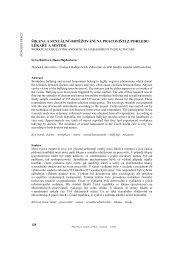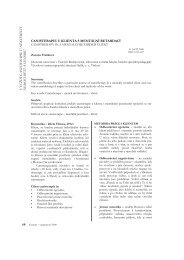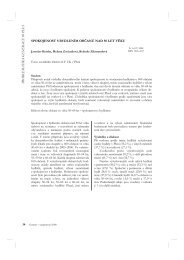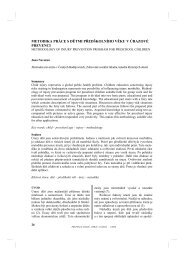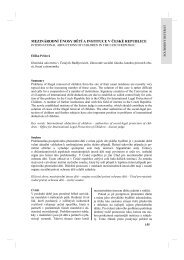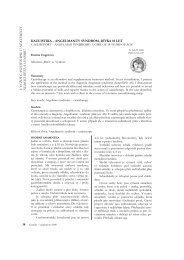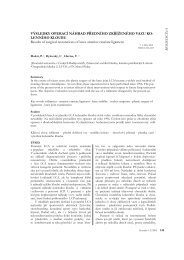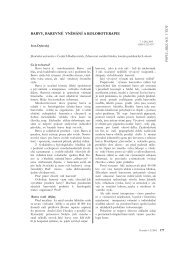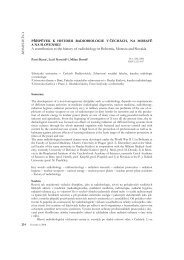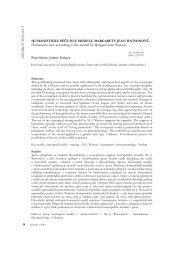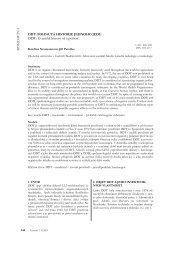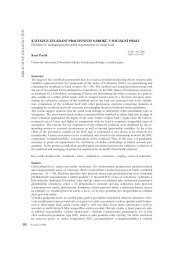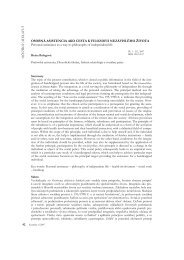REVIEW
REVIEW
REVIEW
Create successful ePaper yourself
Turn your PDF publications into a flip-book with our unique Google optimized e-Paper software.
common. The norm is 1.0–1.4. The index<br />
lower than 0.9 indicates extremity ischemia<br />
and lower than 0.6 a critical ischemia.<br />
The patients with a proven sensitivity loss,<br />
i.e. advanced neuropathy, are dispensed to<br />
a high risk group and can have the diabetic<br />
shoes prescribed. Patients with diagnosed<br />
extremities ischemia are indicated for<br />
angiography examination and the following<br />
intervention solution (committee of the Czech<br />
diabetologic organization 2012a).<br />
Education<br />
The education of the patient in prevention<br />
of the diabetic foot development is a neverending<br />
process. Education that is not repeated<br />
loses its effectiveness. The education of the<br />
diabetic patients in prevention of the diabetic<br />
foot development consists of some basic<br />
points.<br />
1) Wear corrects shoes, never walk barefoot,<br />
not even at home.<br />
2) Check your feet daily. If you are not able<br />
to see there, use a mirror or ask a family<br />
member for help.<br />
3) Maintain correct hygiene standards –<br />
daily feet bath in lukewarm water.<br />
4) Remove the rough skin with a pumice<br />
stone, use files when taking care of your<br />
feet, cut your nails straight after soaking<br />
in lukewarm water.<br />
5) Do not forget that your feet don’t feel<br />
warm, cold and pain well and protect<br />
them before possible injuries.<br />
The main target of the education is reaching<br />
a change in the patient’s behavior. Education<br />
must be comprehensible, lively discussion is<br />
more suitable than a monotonous lecture. The<br />
best option is the combination of presented<br />
information with a written text allowing the<br />
patients to revise the obtained information at<br />
home. It is necessary to adapt the education<br />
for the target group, naturally in blind, poorly<br />
mobile diabetic patients, it is necessary to<br />
work with the family members. It is necessary<br />
to win the active cooperation of the patients<br />
so that they have their feet checked by the<br />
physician, because no checking of a diabetic<br />
patient can be considered as complete if the<br />
feet weren’t checked (committee of the Czech<br />
diabetologic organization 2012b).<br />
In the everyday contact with the patients<br />
who have lost their foot/leg, it is possible<br />
determine a mistake, easily to be seen a mile<br />
137<br />
Diabetic food syndrome<br />
off, which, however, was the fatal mistake<br />
leading in its consequences to the extremity<br />
loss and that could be prevented in many<br />
cases if the care was correct.<br />
Diabetic foot syndrome economy<br />
The care of the patients with a diabetic<br />
foot syndrome is financially demanding<br />
for both the out-patient and the in-patient<br />
departments of the health care institutions.<br />
The treatment expenses can be generally<br />
divided into the direct, health care expenses<br />
(the work of the physician and using<br />
treatment products), direct non-healthcare<br />
expenses (activities of other kind than<br />
healthcare, connected with the treatment –<br />
e.g. the transport) and the indirect expenses,<br />
i.e. potential sources lost due to the disease<br />
(productivity loss due to inability, workload<br />
change, premature retirement, premature<br />
death). Not only antibiotics are financially<br />
demanding, but also the hospitalization and<br />
the diagnostic methods, or even seemingly<br />
low expenses as bandages of the defects by<br />
the nurses of the homecare services, transport<br />
with ambulance cars etc., if the problems last<br />
for months. The diabetology center in Plzeň<br />
tried to retrospectively quantify the half-year<br />
direct costs for health and social care (only the<br />
bandages by a homecare service are included)<br />
of a patient with the diabetic foot syndrome<br />
for the year 2000. It was on average 34,500<br />
Czech crowns per patient per half a year.<br />
In the diabetology center IKEM in the same<br />
year, the costs per a patient with a diabetic<br />
foot were about 2,800 Czech crowns per a day<br />
of hospitalization (without the angiography<br />
and vascular reconstruction procedures).<br />
Hospital treatment of the defect cost<br />
22,500 Czech crowns for a hospitalization<br />
of 26 days length on average. The total outpatient<br />
department care for one patient cost<br />
7,250 Czech crowns (monitored for 8 months).<br />
The amputation cost 22,000 Czech crowns for<br />
20 days of hospitalization on averages. Costs<br />
of compensation tools and social allowances<br />
were up to 400,000 Czech crowns in the first<br />
year after the amputation (Bruner and Anděl<br />
2002).<br />
Amputation<br />
Periphery amputation<br />
Toes amputation, even multiple, disturbs<br />
the stability of standing only minimally. In



